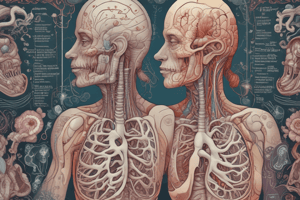Podcast
Questions and Answers
What is the pressure existing in the pleural cavity?
What is the pressure existing in the pleural cavity?
- Transpulmonary pressure
- Intrapleural pressure (correct)
- Intra-alveolar pressure
- Intrathoracic pressure
What is the primary function of intrapleural pressure?
What is the primary function of intrapleural pressure?
- Causing flow of air in and out of alveoli
- Preventing the collapsing tendency of lungs (correct)
- Aiding in the exchange of gases between alveolar air and blood
- Causing dilatation of vena cava and larger veins in thorax
What is the significance of intra-alveolar pressure during inspiration?
What is the significance of intra-alveolar pressure during inspiration?
- It causes dilatation of vena cava and larger veins in thorax
- It helps in the exchange of gases between alveolar air and blood
- It becomes negative, causing the entry of atmospheric air into alveoli (correct)
- It becomes positive, causing the expulsion of air out of alveoli
What does transpulmonary pressure represent?
What does transpulmonary pressure represent?
What exerts suction on the fluid that lines the pleural cavity?
What exerts suction on the fluid that lines the pleural cavity?
During inspiration, the intra-alveolar pressure becomes positive.
During inspiration, the intra-alveolar pressure becomes positive.
Intrapleural pressure is always positive.
Intrapleural pressure is always positive.
Intrapleural pressure prevents the collapsing tendency of lungs.
Intrapleural pressure prevents the collapsing tendency of lungs.
Intra-alveolar pressure causes flow of air out of alveoli during expiration.
Intra-alveolar pressure causes flow of air out of alveoli during expiration.
Transpulmonary Pressure is the sum of intra-alveolar pressure and intrapleural pressure.
Transpulmonary Pressure is the sum of intra-alveolar pressure and intrapleural pressure.
Study Notes
Pressure in the Lungs
- Pressure in the pleural cavity is typically negative, ranging from -3 to -5 mmHg.
Functions of Intrapleural Pressure
- The primary function of intrapleural pressure is to prevent the collapsing tendency of lungs.
Respiration Process
- During inspiration, intra-alveolar pressure becomes negative.
- Intra-alveolar pressure causes airflow into the alveoli during inspiration.
- During expiration, intra-alveolar pressure becomes positive, causing airflow out of the alveoli.
Transpulmonary Pressure
- Transpulmonary pressure represents the sum of intra-alveolar pressure and intrapleural pressure.
Pleural Cavity
- The negative intrapleural pressure exerts suction on the fluid that lines the pleural cavity.
Studying That Suits You
Use AI to generate personalized quizzes and flashcards to suit your learning preferences.
Description
Test your knowledge of the pressures exerted in the thoracic cavity and lungs during respiration. Explore concepts such as intrapleural pressure, intra-alveolar pressure, and their significance in the respiratory process.



